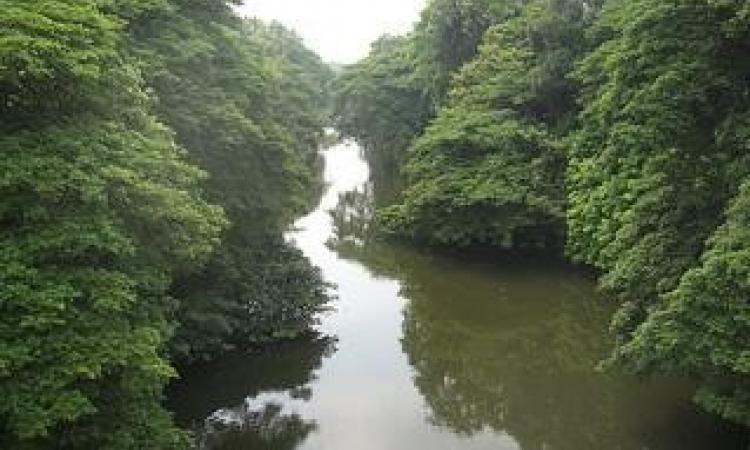
Karamana, the pride of Thiruvananthapuram and an important source of drinking water for the city, is now dreaded and diseased. Parts of the river have been closed to residents now because they are so polluted. What was once a thriving river is now being used as a garbage dump. I decided to trace the path of the river to see how bad the damage really was.
The Karamana originates from the Agastyarkoodam mountains located at the southern tip of the Western Ghats. It then flows 68 kilometres westward and merges into the Arabian sea at Thiruvallam. Thiruvananthapuram, the capital of Kerala, lies fully within the 702 square km area that the river encompasses. [1,16]. The river is an important water resource to meet the domestic and drinking water needs of the population in Thiruvananthapuram city [16].
A wide variety of tropical plants including wild cane, bamboo and water lilies are found along the river bank. The cerbera odollam, called othalam in Malayalam, is found along the lower reaches of the river [2]. Different varieties of fish including karimeen, chekkaali, kariyida, pruminali, cherumeen and vaala are found upstream and nedumeen, aaral, maalavu, paaval downstream in the river [2].
Dammed at its origin
The Karamana river has two important dams where it originates from the Agastyarkoodam mountains. These are the Peppara dam built in 1983, which lies upstream, and the Aruvikkara dam located below and built in the 1930s. Both meet the irrigation and drinking water supply needs of Thiruvananthapuram city.
The 423m long Peppara dam unites all the upper tributaries of the Karamana river and regulates the water flow to the Aruvikkara dam. There is also a 3MW hydro-electric power station here. The dam has been built to control the flooding of the Karamana river [5].
The Peppara dam
The road to the Peppara dam is a beautiful kaccha road flanked on both sides by thick vegetation. The Peppara wildlife sanctuary, which preserves a large variety of trees and wildlife species including tigers, panthers, lion-tailed macaques, Malabar squirrel and a range of birds, snakes and butterflies is also located here.
I reached the dam site and filled in my details at the security counter. “Cameras not allowed”, said the sign due to security reasons. While walking over the bridge, I noticed the rocks at the bottom of the river. Some of them seemed a bit eroded confirming my suspicions that the water levels had receded due to poor rainfall. I realised that the water situation in the city indeed seemed to be bad this year due to this drastic reduction in water levels in the dam.
Desperate measures have been thought of to deal with this situation such as installing hand pumps or bore wells in residential areas for every 10 houses [8], using water from the Vamanapuram river and other waterbodies in that region, setting up desalination/reverse osmosis plants on the Thiruvananthapuram coast [8] and increasing the capacity of the dam [9].
However, with the arrival of the monsoons this month, the Kerala Water Authority is hopeful of the increase in water levels in the dam and is only pumping water from the Aruvikkara dam to meet the drinking water needs of the city. I walked away wondering how this situation will impact me.
The Aruvvikara dam
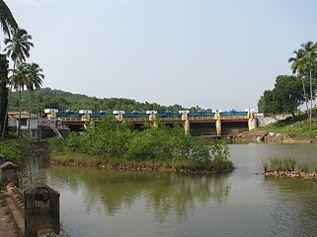
The Aruvikkara dam is a small dam overlooking a temple. The drinking water for residents of the city comes from the Aruvikkara dam with the help of four pipe lines from the outskirts of the city. The road to the Aruvikkara dam is initially a pucca road and starts getting kaccha as one moves along.
Since the work of the pipeline repair and renovation to supply water to different parts of the city was ongoing [9], most of the roads were in a terrible state. Huge pipes carrying water from the dam to the cities lay exposed below. I reached a parking spot at the end of the road and stood on a bridge that had a beautiful view of the dam, but what lay beyond was far from beautiful.
The conflict over water distribution between private and public tankers at Aruvikkara
 I saw a number of water tankers driving up and down the roads to reach the city. There were huge pipelines carrying water from the dam flanked by taps in a line. Both private and public tankers took water from here to supply to the city. Even the filling up of water did not happen smoothly as there was some sort of a conflict between the two.
I saw a number of water tankers driving up and down the roads to reach the city. There were huge pipelines carrying water from the dam flanked by taps in a line. Both private and public tankers took water from here to supply to the city. Even the filling up of water did not happen smoothly as there was some sort of a conflict between the two.
A large number of institutions in the city depend heavily on the water carried by private tankers all the way from Aruvikkara to the city. While talking with people there, I found out that a flash strike had been called by the Private Tanker Lorry Association that supplied water to major offices, hotels and hospitals in the city. Their demands were simple – they did not want any restrictions put on the time that they could access this water and they also did not want any restrictions on the amount of water they could take. More than a hundred private tanker lorries were a part of the strike.
While the authorities denied that there were any kind of restrictions on the lorry drivers, the lorry drivers had a different story to tell. They said that they were not allowed to transport water from the Aruvikkara dam after 10 p.m. Around 200 lorries travelled daily on this route. They often incurred huge losses due to these restrictions as they were hardly able to transport more than two loads on every day.[12] The authorities said that the strike was part of the lorry owners’ move to increase the price of water [13].
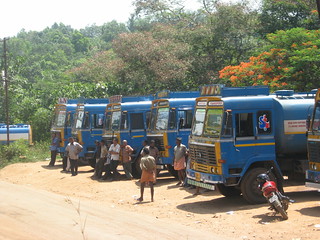
I came to know later that the conflict had been resolved, but wondered about the fragility of this arrangement. How long could this take care of the water needs of our cities over the years to come? With water becoming even more of a scarce resource because of poor rainfall, how much worse could the situation become?
The path of the Karamana river into Thiruvananthapuram
From the Aruvikkara dam, the river snakes into the city passing through a number of bridges, temples and bathing ghats. I followed the river at the Vellaikadavu bridge after the Aruvikkara dam and then the Mangattukadavu bridge, the Thrikkannapuram bridge, the Karamana bridge, the Thamalam Pappanamcode bridge and the bridge at Thiruvallam where she enters the sea.
The Vellaikadavu bridge
The river flows from the Aruvikkara dam through the Moonamudu area to the Vellaikadavu area. This area is used for washing and bathing. It even has a temple in the vicinity, but a stream carrying waste from the waste treatment plant at Villappilsala in Thiruvananthapuram city joins the river through the Meenambally canal between both these areas, and pollutes the river.
There has been a lot of controversy over reports of excessive pollution of the Karamana river due to the dumping of waste materials. The plant has a capacity of 90 tonnes, but the garbage being accumulated in the plant is about 203 tonnes per day, which continues to pollute the river [14].
Mangattukadavu bridge

The Thrikkannapuram bridge
This bridge is slightly outside the main city and appears taller and bigger than the other bridges in the area. Coconut palms abound and the place is beautiful, but it hides something sinister. Reports over the last few years have found that the major stretches of the Karamana river are heavily polluted with the discharge of raw sewage and effluents from industries.
Studies have found that the river is highly polluted in the Thrikkannapuram area and the water is highly acidic with very high levels of bacterial contamination [16]. Besides this, there have also been recent media reports about unauthorised sand mining in Thrikkannapuram [17].
The Karamana Bridge
Built in 1853, this is the largest bridge in the city with the National Highway 47 crossing here. The river is named after a suburb of Trivandrum city, Karamana, through which it enters the city. One does not notice the path to go down the bridge in the midst of cars whizzing about from the two sides of the bridge. A side road leads to the ghat steps that reach the river. In the past, people took a dip before visiting the temple.

As I went there, the sides under the bridge and the steps leading to the river looked forlorn, totally ignored and full of waste and garbage strewn along its path. Only street hawkers and beggars seemed to frequent this place. One could see an occasional person taking a dip in the water. It seemed like it was only the poor and homeless who turned to the river as they had no other alternative left.
On the right of the steps is the the Sree Sathyavageeswara temple. As I went there, the water near the ghats seemed to be slightly stagnated and mixed with the garbage from the sides. However, a view of the river from the bridge was truly breathtaking.
The Thamalam-Pappanamcode road and bridge

The river next enters into the Karamana, Pappanamcode and Mudavanmugal areas of the city. A bridge over the river at the Karamana Pappanamcode site connects the two areas. People still use a small boat to ferry across these two areas of the city across the river. The actual bridge, although small, is used by people and two wheelers and rickshaws.
As I went down towards the river from the sides of the bridge, there were steps to go down, but they were full of garbage. Although the view of the river from the bridge was beautiful, I couldn't help but notice the garbage spread around near the river bank indicating disuse and neglect. The waters here looked slightly blackish as compared to other places.
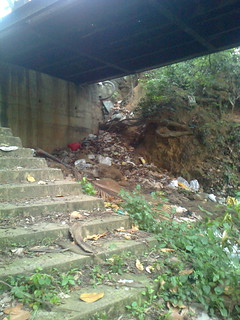
A study conducted by the Kerala State Council for Science, Technology and Environment (2010) has found that the water quality index of the river as she enters into the areas of Karamana, Pappanamcode and Mudavanmugal is poor. Extensive discharge of domestic effluents and industrial wastes into the river has led to this.
Thiruvallam
The Karamana river ends at Thiruvallam after which it joins the sea at the Edayar island near the Poonthura estuary. Thiruvallam has an ancient Parashuram temple on the banks of the river and is also famous for its backwaters with major attractions such as canoe rides, water sports, floating bridge and short village cruises (using the country boats) [18].
On the right of the Thiruvallam bridge is the Parshurama temple, the only one in Kerala, which is famous for a religious ritual of bali (sacrifice) during the Karkidaka Vavu day (a holiday in the Malayalam month of Karkidakam). On this day, devotees pay homage to the departed souls of forefathers after taking a dip in the holy water.
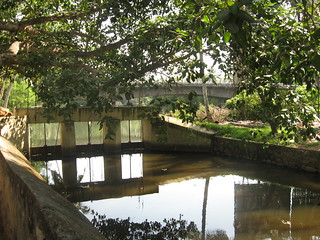
As I went there, the sides that took me to the lower part of the bridge also bore the same ignored, forlorn look with occasional beggars and street hawkers sitting near the banks of the river. I couldn't go any further.
There were boards displayed near the ghats telling me to refrain from entering the water because of its very high pollution levels. People sitting near the temple informed me that even the water from the banks of the river below the bridge were highly polluted and that a large number of fish had died due to this.
There have also been recent reports of outbreaks of leptospirosis, an infection caused by contact of contaminated water with the skin, eyes or mucous membranes, in the area. The primary health centre has issued a ban on boating, swimming, fishing or any other activities near the river [19]. I had to cancel my plan of tracing the river path from Thiruvallam to where it ends at the Edayar estuary because of this ban.
This high level of contamination at Thiruvallam has been caused by the discharge of domestic effluents, drainage and sewage through the Parvathi Puthanar canal into the river [19]. This has created a difficult situation for the people, since the river is their main source of water. The stagnant waters in parts of the river are now breeding sites for mosquitoes and increase the risk of dengue epidemic, which has been found to be on the rise in the city. The ‘bali rituals’ at the Parasurama temple have also been affected [19, 20].

Recent attempts at cleaning and restoring the river
Studies analysing the water samples collected from 20 locations along the river have shown contamination from different sources resulting in poor water quality, especially in the downstream areas. Seventy-five per cent of the river water samples have been found to be acidic in nature and 53 percent bacteriologically contaminated [15].
This pollution has led to the conversion of the river into a carrier of filth and diseases leading to environmental damage and increased the risk of public health hazards. Increasing attention is now being directed to the plight of the Karamana over the last few months. According to the latest news following World Environment Day, The Kerala State Council for Science Technology and Environment and the Kerala State Biodiversity Board have initiated proposals for integrated river basin management projects focusing on cleaning up and restoring the Karamana river [21, 22, 23]
The story of all rivers in India and the way forward
This is more or less the story of all rivers in India. Rivers are considered as resources and mere commodities to be utilised and looted for their water, sand and fish without taking into consideration their natural flow and the ecosystem they support. Dumping of garbage, industrial effluents, wastewater and sewage adds to a river's woes.
Water doesn't just flow continuously from taps and pipes. City dwellers often forget that. Rather than set aside huge amounts of money and resources to clean up a polluted river, the effort is better spent on preventing this pollution. Efforts made to revive and restore our rivers can/need to be done at multiple levels. These include:
- enforcement of strict laws preventing industries from discharging untreated effluents into the river
- enforcement of laws to stop the practice of dumping waste, untreated sewage and organic and inorganic wastes into the river making it filthy and polluted.
- devising of proper and efficient waste management systems to take care of the huge amounts of garbage generated, including separation of organic and inorganic wastes at the source and devising mechanisms to use the treated organic wastes as compost in agriculture or for biogas generation.
- maintaining of the ecological balance of the rivers
As common citizens, we first need to be aware of the various factors that lead to the pollution of rivers in our country. We can do our own bit by trying to minimise waste produced and separating waste at the source, limiting the wastage of water and making use of recycled water.
In addition to this, social activism through making other people aware of the issues related to river pollution and taking up activities such as being responsible for maintaining and restoring of the rivers or water bodies in our areas can go a long way in maintaining the health of rivers in our country.
References
- Government of Kerala (2013) Water Resources. Downloaded from the site: http://www.jalanidhi.kerala.gov.in/index.php/watersector/water-resources- on the 3rd June 2013
- Achuthsankar S Nair (2012) And Quiet Flows The Karamana: The river wild. The Hindu. Downloaded from the site: https://www.thehindu.com/sci-tech/energy-and-environment/the-river-wild/article4077504.ece on the 3rd of June 2013
- Achuthsankar S Nair (2012) And quiet flows the Karamana: Bridging past and present. The Hindu. Downloaded from the site: https://www.thehindu.com/features/friday-review/history-and-culture/and-quiet-flows-the-karamana-bridging-past-and-present/article3892830.ece on the 3rd of June 2013
- Wikipedia (2013) The Karamana river. Downloaded from the site: http://en.wikipedia.org/wiki/Karamana_River on the 3rd of June 2013.
- Achuthsankar S Nair (2012) And quiet flows the karamana: tapping the river. Downloaded from the site: https://www.thehindu.com/features/friday-review/history-and-culture/and-quiet-flows-the-karamana-tapping-the-river/article4009454.ecee on the 3rd of June 2013
- The Hindu (2013) KWA scouting for new sources of water Downloaded from the site: https://www.thehindu.com/todays-paper/tp-national/tp-kerala/kwa-scouting-for-new-sources-of-water/article4741792.ece on the 3rd of June 2013.
- Ente city (2013) Drought looming over Traivandrum. Downloaded from the site: http://news.entecity.com/drought-looming-over-trivandrum/ on the 3rd of June 2013.
- The Hindu (2013) KWA scouting for new sources of water. Downloaded from the site: www.thehindu.com/todays-paper/tp-national/tp-kerala/kwa-scouting-for-new-sources-of-water/article4741792.ece on the 3rd of June 2013
- The New Indian Express (2013) Pipe bursts will soon be history. Downloaded from the site: http://newindianexpress.com/cities/thiruvananthapuram/article1509315.ece?service=print on the 3rd of June 2013.
- The Hindu (2012) And quiet flows the karamana: Tapping the river. Downloaded from the site: https://www.thehindu.com/features/friday-review/history-and-culture/and-quiet-flows-the-karamana-tapping-the-river/article4009454.ecem on the 3rd of June 2013
- The New Indian Express (2013) Officials take steps to counter private tankers strike. Downloaded from the site: http://newindianexpress.com/cities/thiruvananthapuram/Officials-take-steps-to-counter-private-tankers-strike/2013/05/20/article1598011.ece on the 3rd of June 2013
- The Hindu (2013) Private tankers strike work. Downloaded from the site: https://www.thehindu.com/news/cities/Thiruvananthapuram/private-tankers-strike-work/article4729800.ece on the 3rd of June 2013.
- Kaumudi online (2013) Private tankers strike work. Downloaded from the site: http://kaumudiglobal.com/innerpage1.php?newsid=36369 on the 3rd of June 2013
- Khaleej Times (2012) Garbage plant polluting drinking water source. Downloaded from the site: http://www.khaleejtimes.com/displayarticle.asp?xfile=data/international/2012/January/international_January684.xml§ion=international&col on the 3rd of June 2013
- Kerala State Council for Science, Technology and Environment (2010) Environmental monitoring programme on water quality. Downloaded from the site: http://www.indiaenvironmentportal.org.in/files/front%201-26%20pages.pdf on the 3rd June 2013.
- The Hindu (2013) Karamana river heavily polluted, says study. Downloaded from the site: https://www.thehindu.com/todays-paper/tp-national/tp-kerala article547509.ece?css=print on the 3rd June 2013.
- The Hindu (2012) And quiet flows the Karamana- karamana chronicles. Downloaded from the site: https://www.thehindu.com/features/friday-review/history-and-culture/and-quiet-flows-the-karamana-karamana-chronicles/article4098239.ece on the 3rd June 2013
- Thiruvallam (2010) Downloaded from the site: http://trivandrumdistrict.blogspot.in/2010/10/thiruvallam.html on the 3rd of June 2013
- The Hindu (2013) A polluted river opens the floodgates to health issues. Downloaded from the site: https://www.thehindu.com/news/cities/Thiruvananthapuram/a-polluted-river-opens-the-floodgates-to-health-issues/article4636238.ece on the 3rd June 2012
- RupeeRains News (2013) Polluted Karamana puts Thiruvallam on the edge. Downloaded from the site: http://rupeerains.co.in/polluted-karamana-puts-thiruvallam-on-the-edge/0427143759/ on the 3rd of June 2013.
- The Hindu (2013) River restoration project on the cards. Published in the Hindu, June 5, 2013
- The Hindu (2013) Karamana river to get a wash. Published in the Hindu, June 7, 2013
- The Hindu (2013) Salvation in sight for rivers and ponds. Published in the Hindu, June 10, 2013
- Achuthsankar S Nair (2012) And quiet flows the Karamana. Published in the Hindu. Downloaded from the site https://www.thehindu.com/sci-tech/energy-and-environment/and-quiet-flows-the-karamana/article3866606.ece on 13th June 2013